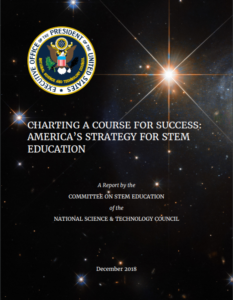 On December 4, the Committee on STEM Education of the National Science and Technology Council released Charting a Course for Success: America’s Strategy for STEM Education, a report that outlines the Trump administration’s five-year strategy to increase access to high-quality Science, Technology, Engineering and Mathematics (STEM) education and to ensure the United States is a global leader in STEM literacy, innovation and employment. The strategy is rooted in three goals: build strong foundations for STEM literacy; increase diversity, equity and inclusion in STEM; and prepare the STEM workforce for the future.
On December 4, the Committee on STEM Education of the National Science and Technology Council released Charting a Course for Success: America’s Strategy for STEM Education, a report that outlines the Trump administration’s five-year strategy to increase access to high-quality Science, Technology, Engineering and Mathematics (STEM) education and to ensure the United States is a global leader in STEM literacy, innovation and employment. The strategy is rooted in three goals: build strong foundations for STEM literacy; increase diversity, equity and inclusion in STEM; and prepare the STEM workforce for the future.
To achieve these goals, the strategy is broken into four pathways that respectively focus on:
- Building and strengthening relationships between education institutions, employers and their communities;
- Making STEM learning more meaningful for students by engaging students in transdisciplinary activities and real-world problems;
- Advancing computational literacy as a critical skill; and
- Committing to evidence-based practices and decision-making in STEM programs.
The pathways described in the strategy share common items with STEM4: The Power of Collaboration for Change, a resource by Advance CTE, the Association of State Supervisors of Mathematics, the Council of State Science Supervisors, and the International Technology and Engineering Educators Association that outlines principles and corresponding recommendations to drive and implement outstanding STEM education research and practices.
Notably, both resources recognize the importance of increasing access to and equity in STEM preparedness and the importance of real-world scenarios to preparing learners for lifelong career success. Career Technical Education (CTE) can play a pivotal role in promoting strong STEM education programs and workforce by exposing learners of all ages to real-world experiences through work-based and experiential learning and by fostering a STEM talent pipeline. High-quality CTE programs of study are informed by labor market data and developed with industry input to ensure that learners are developing the skills, such as computational literacy, to meet employer needs.
As the United States continues to fall short in preparing learners for education and careers in STEM, state leaders should consider how CTE can serve as mechanism to meet the goals outlined in the Trump administration’s five-year strategy.
Brianna McCain, Policy Associate
Tags: STEM, Trump Administration

